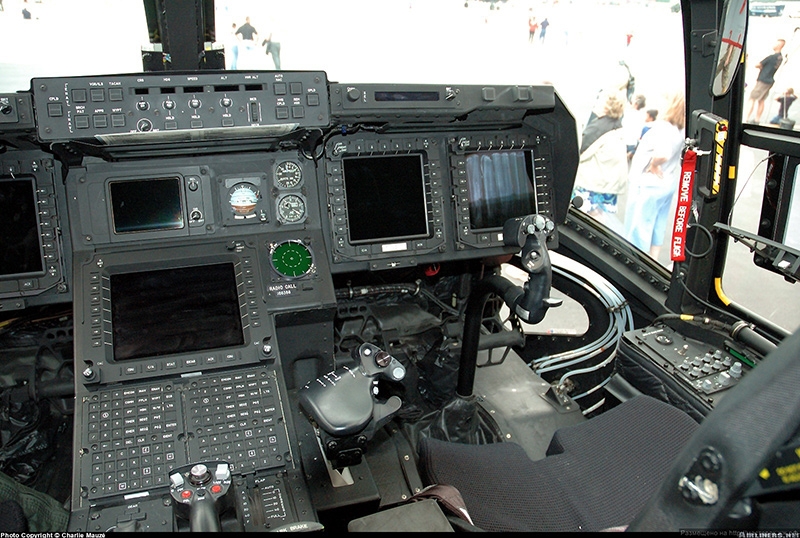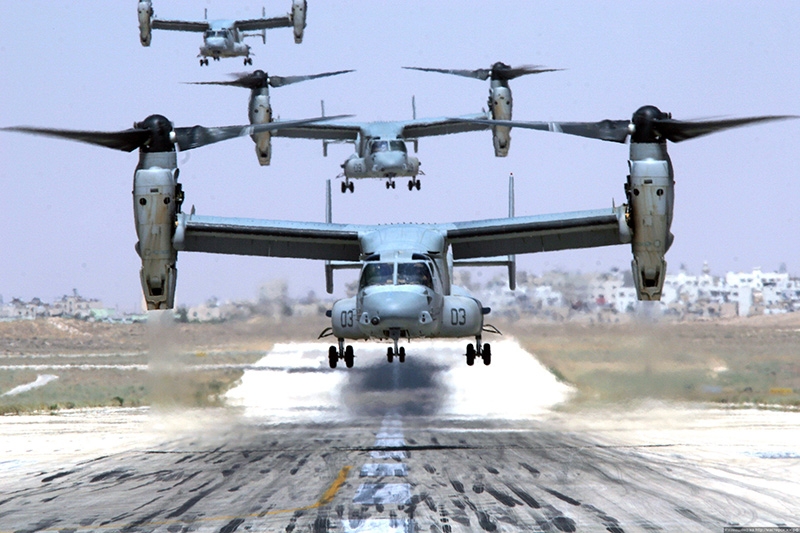
Bell V-22 Osprey (with English. osprey — скопа) - American tiltrotor, It combines the advantages of individual aircraft and helicopter. The only commercially available tiltrotor developed in the USA more 30 years Boeing and Bell companies. It is in service with the US Navy and US Marine Corps.
V-22 Osprey – video
The aircraft is equipped with two engines Rolls-Royce T406, arranged at the ends of the wing in nacelles, which can be rotated by almost 98 degrees. Screws with three trapezoidal blades interconnected synchronizing shaft, which extends inside the wing. This shaft also provides the possibility of landing the aircraft on one engine. In order to reduce the structural weight of about 70 % (5700 kg) the device is made of composite materials based on carbon- and fiberglass with epoxy binder, It is making it easier for a quarter of the metal counterpart.
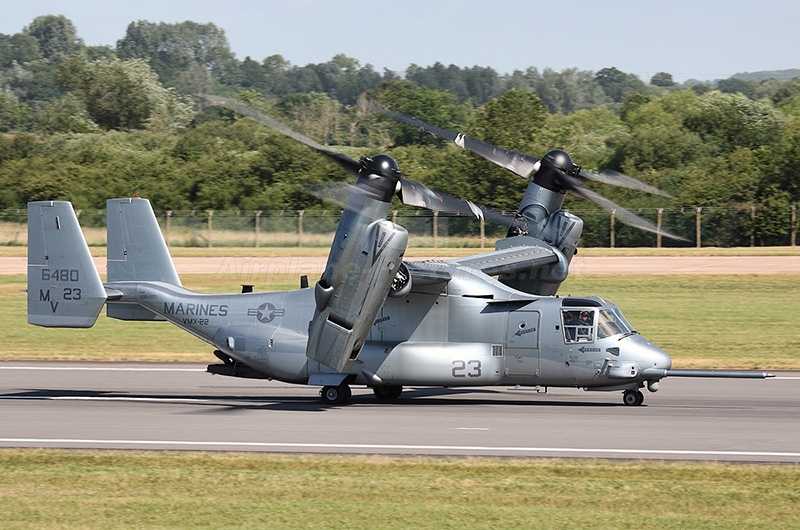
Among the most interesting aircrafts, which have no analogues in other countries, enters US tiltrotor (aircraft-airplane) V-22 "Ospri». We spent on its development 25 years, and disaster, that occurred during flight tests, claimed the lives 30 human. US Defense Department has spent on the program 20 billion and, As expected, spend more 35 billions of dollars (the amount given in some sources almost 50 billions of dollars). The cost of one serial tiltrotor is estimated at 110-120 million dollars.
The program several times was under threat of closure. for example, US Secretary of Defense Cheney P. four times gave orders to stop funding the program V-22, but each time the Minister's decision reviewed. In all cases, the head of the Defense challenged the decision of the Congress. The main argument in favor of the continuation of the work was the desire to save jobs, as in the manufacture of VTOL or otherwise involved in the enterprise 63 percent of the United States federal districts. Also, there have been cases of indirect bribery of congressmen and senators "Boeing" and "Bell". In this case, there is even today a powerful opposition to the V-22, who believes, helicopter Sikorsky CH-53K, which 2013 year plan to adopt, able to more efficiently perform all tasks, imposed on a tiltrotor "Osprey". but, airspeed V-22 twice, than other helicopters, and it is able to carry a large payload tripled compared to the CH-46. "Osprey" on the flight distance in 5 times the helicopter CH-46, he must be replaced. Tactical radius of V-22 "Osprey" – 648 km, which makes it possible to eliminate the basing tiltrotor in the vicinity of "hot spots" or frontline.
Information about the development of
US Department of Defense in the late 1970s has developed prerequisites multipurpose VTOL tilt-rotor Army, Air Force, Aviation Navy and Marine Corps. The main developer of the aircraft by JVX program (Joint-service Vertical take-off/landing Experimental aircraft) at 1982 year were chosen "Boeing helicopter" and "Bell". In January 1985 VTOL year awarded the designation V-22 "Osprey". At this stage, the program cost is estimated at 2,5 billion, and the program (considering the purchase of 913 vehicles) - at 35,6 billions of dollars. Further, the number of purchased VTOL sequentially decreased, in the beginning - to 657 PC., and in May 1994 the number of planned production cut to VTOL 458 serial konvertoplanov.
AT 1986 year began full-scale design. The project is based on a tiltrotor Bell XV-15, which 1977 year made its first flight. Building the first prototype vertical takeoff / landing V-22 "Osprey" completed in late May 1988 of the year, 19 Martha 1989 the year the first flight with a delay of almost 8 months of relative schedule. AT 1990 , the third and fourth copies successfully completed the 1st stage of sea trials, Performs on "Wasp" – desantnom korable midshipmen.
In connection with the crash 20 July 1992 year flight test prototypes suspended until August 1993 of the year. AT 1997 year began flight tests of the 4 pre-series V-22. In October 1999 , began operational tests. After the two accidents occurred during the execution of the program of operational tests 8 and 14 April 2000 of the year, All flights stopped on 1,5 year and resumed only in May 2002 of the year.
V-22 tested for the study of the regime "vortex ring" in large volumes, compared to any other known rotorcraft. The effect of "vortex ring" describes not a lot of time new, unstudied phenomenon. The effect of "vortex ring" is shown at helicopters, that fly with little forward speed, but with a large vertical descending speed. In this case the rotor blade beginning to enter the vortex flow, which was set up by this rotor, Therefore, the lift of the blades drastically reduced.
During the tests revealed "extreme point", in which the machine falls into the "vortex ring" mode. The first sign "vortex ring" was recorded at a rate of descent 488 meters per minute, and at a speed of 610 meters per minute, the effect of "vortex ring" is fully manifested. Failure occurred in Marone at rate of descent 670 meters per minute. In it was found during further research, that tiltrotor mode "vortex ring" is manifested in high velocity and altitude range, than in helicopters. The "vortex ring" mode begins and develops much faster.
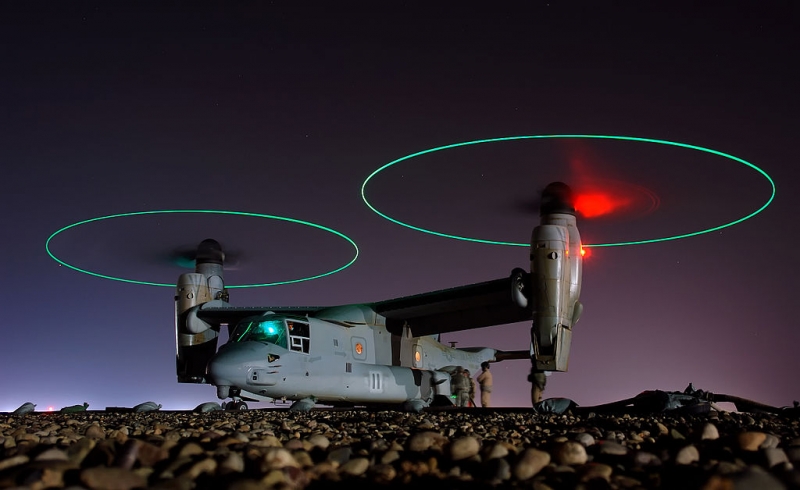
MV-22 Osprey - Night Refueling
As the VTOL aircraft can not perform landing in "airplane" mode, the requirement, which was put forward by the Marine Corps, autorotative landing in mechanical failures or failure of both engines seemed logical. Marine Corps in 2002 he made the request. An unnamed adviser of the United States Defense Department in a confidential report for the 2003 year waiver of landing in autorotation described as "unacceptable", as "autorotation enables pilots to save their lives and the lives of passengers" and "is often used in a combat situation".
After the disaster the development and testing of the program itself tiltrotor subjected to scrutiny. Conclusion was, that the development of the new device, instead of V-22, It takes several years and millions of dollars financing costs, therefore preferable to leave the program V-22, but pay extra attention to the study mode "vortex ring" and the effect of ground effect. Theoretical studies conducted NASA. Space Agency experts in November 2002 year recommended an additional. study the problem of "vortex ring" and eliminate land in autorotation of the requirements for "Osprey". In addition to scientific and technical problems, program analysis showed the negative impact of "administrative resources" to work on konvertoplanov - different structures, interested in the program of the V-22, for various reasons, we put pressure on the management of the program to accelerate the work.
Despite the suspension of the flight test program, small-lot production of the V-22 "Osprey" continued, first of all, for testing of technical processes. Parallel to improved design of the device taking into account the recommendations of NASA, developed in the study of the causes of accidents 2000 of the year. The design made hundreds of changes, concerning, mainly, nacelles and software improvements. The changes have taken into account in the construction of "block B" units, and "Block A" devices have been finalized.
29.05.2002 resumed flight tests, when tiltrotor №10 performed flight Patuksen River. Flying machine started №8 19.10.2002.
flight tests
The program of the initial test, which started in 1992 year, Cycled 5 konvertoplanov – №21, 22, 23, 24 and 34. №21 - the first production tiltrotor, modified to the level of "block A", №34 - first MV-22B «block A». On the MV-22B №34 (construction completed in August 2003 year) reduced structural mass, seriously redesigned nacelles and software.
Park in konvertoplanov 2003 He was flown by the test program 1000 hours without air accidents. During the tests was checked again the opportunity to produce a tiltrotor combat maneuvering, studied takeoff / landing modes, to develop methods of refueling in flight. Washer and №№21 22 carried out in the dark flight systems. Also, the unit №21 flew to Fort Bragg to explore the possibility of landing people and cargo up to 900 kilogram parachute way. Tiltrotor №24 from December 2003 to April 2004 , the simulated ice patrol in Nova Scotia.
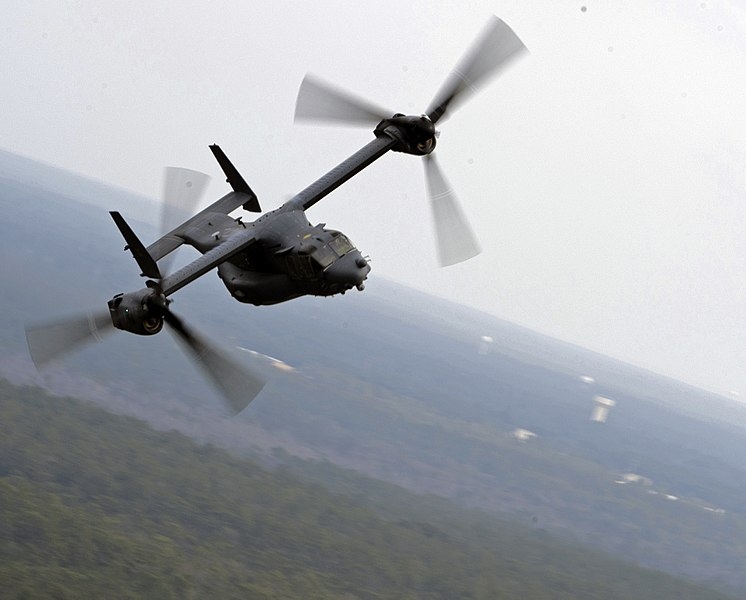
The ships held two rounds of testing. The main goal - to develop planting technique on ship. In January 2003 the flights with helicopter landing "Iwo Jima" carries the unit №10, and in November of the same year - a "Bataan" ship carried machine №22. Stage IVB initial test (Compatibility of the ship and tiltrotor) It was completed in June 2004 of the year. Tests for 8 days were carried out near the Maryland coast aboard the "Iwo Jima". During the test for based on the possibility of courts, conducted in 1999 year, it was revealed spontaneous krenenie unit during hovering above the deck. Krenenie MV-22B unit managed to exclude due to reprogramming of the control system.
The last stage of testing of ship, bore the name "Phase IVC», was conducted 12 November 2004 year for 10 days on the helicopter carrier "Wasp". During this phase were involved tiltrotor №№10, 21 and 23. During the tests,, I tested the possibility of taking off / landing on a ship in the dark, and the impact of soaring machine to machine, who are ready to take off; tested the ability to repair and maintenance konvertoplanov on board. Flight tests of the peak reached in 2004 year. To test the program joined the car number 9, upgraded in version CV-22B. In China Lake on the CV-22B in March 2004 year to verify the compatibility of avionics. In April of the same year, for the first time after the resumption of flights of V-22 "Osprey", practiced aerial refueling: экипаж V-22 ITT (Lt. Col. Kevin Gross and Steve Grobsmeyer, test pilot of the company "Boeing") near Pataksen River 5 again performed "dry" contact with the tanker. №22 The device was equipped with a non-retractable rod fuel consumer (length 3,35 m), and the machine №21 – telescopic rod (length in the extended position 2,74 m). In April 2004 year at the airbase Shirvater (Nova Scotia, Canada) tests were performed on ice: rotor encountered №24 67 hours, of which 37 hours in icing conditions. Park konvertoplanov by August 2004 years from the date of the resumption of operations in the 2002 godu encountered 3 thousand. hours. In August of that year, the flights made by the flight test program 9 vehicles: 2 apparatus (№№7 and 9) Edwards Air Force Base, 7 - at the airbase Pataksen River. Since 29.05.2002 by 31.12.2004 It was committed 730 flights for a total of 1433 hours.
user test
At an air base Marine Corps New River in August 2004 , the formation of the VMX-22 squadron, the main purpose of which was to conduct performance tests, who wore the name "Phase II». Number konvertoplanov statewide squadron was to be 11 machines. 7-13 December 2004 Year aircrew squadron is flying to a landing ship dock "Kearsarge", training continued at the beginning of 2005 of the year, but then suspended due to problems with the bearings. Several konvertoplanov celebrated overheating transmission bearings, so crews perform emergency landings. After chrome bearings Replace bearings, who had chromed, emergency alarm stopped; flights resumed 7 February.
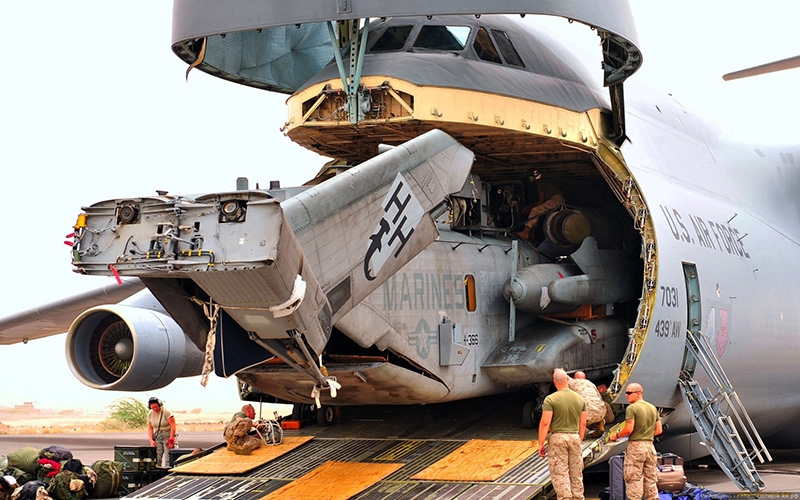
Initial performance tests (Operation Evaluation, OPEVAL) V-22 tiltrotor performed at different locations, including air bases China Lake and River Pataksen, Base Marine Corps in Arizona and North Carolina, Air Force Base in New Mexico and Florida. Marine stages of the test program was carried out on a variety of landing craft on the west and east coast of the United States. I checked for suitability tiltrotor basing on ships, ability to carry out combat missions in the interest of amphibious assault, make flights at low altitudes (including flights with night vision goggles), carry out refueling in flight from tanker aircraft NA-130, carry cargo in the cabin and on the external sling. Also practiced flying formation. The main purpose of the test was to check the tiltrotor's ability to carry out tasks under, close to the fighting. Even though the irregular financing of operational tests, the first phase completed in full, although tiltrotor was found to meet all of 23 of 243 operational parameters to be evaluated.
"New stage (OPEVAL II) performance test took place between 28 March 29 June 2005 of the year. They participated 8 MV-22B Block А. For the tests were used Nellis airbase, Bridgeport, New River, landfills in Texas, New Mexico, Arizona and California. Marine steps are performed in the western Atlantic waters with a landing ship dock "Bataan". tiltrotor, based on the ship, performed tasks at the sites in Mississippi, Virginia and North Carolina.
According to the test results of MV-22B Block A recognized fit for use and meet all the basic requirements of tactical aircraft. The literature notes, that the tiltrotor "Osprey", who completed the performance tests in 2005 year, differs considerably from the V-22, participated in the initial stage OPEVAL. Total raid crews VMX-22 squadron was 750 hours, including a raid in less than 3 months was 196 hours. completed 204 flight, including 89 flight (since the take-off and landing ending) fully simulate combat missions.
During the tests, check the operation of a mission planning system. This system allows you to enter in the job parameters onboard control system with the help of a laptop and reprogram them during the quest. Night flights performed less than planned. Crews used night vision goggles only 6 Percentage of flight time; of 29 flights using night vision goggles planned test program completed 12 (33 hours instead 133).
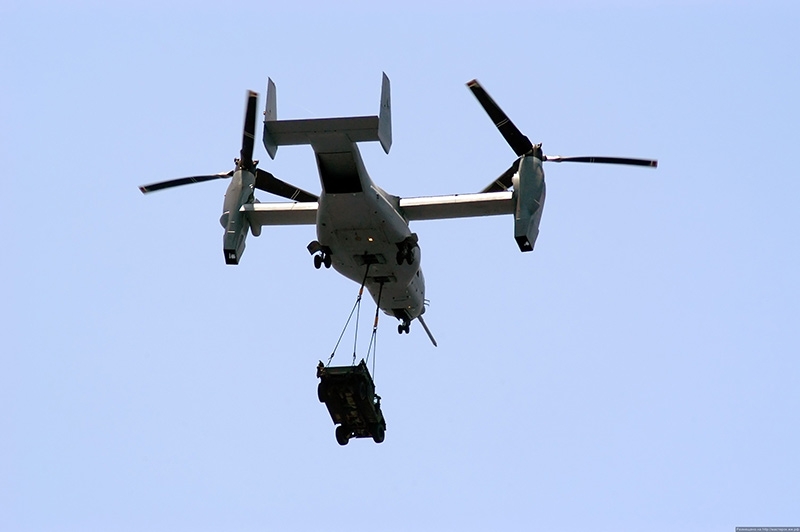
The report on the second stage of operational tests mentioned, convertiplane that V-22 has a significant advantage over the helicopter-46 CH(53) that it is intended to replace. The advantages are high speed and range, large payload mass, improved on-board systems, less time of preparation for the task, best navigation equipment, lower loading of the crew during the flight, less vulnerable to air defense. It was also noted, that were resolved 4 the biggest problems, safety-related, resulted in 2000 year to a loss of 2 konvertoplanov. Two of these problems are directly related to the effect of "vortex ring". When performing tasks did not leave crews VMX-22 squadron in the modes, which are close to the appearance of this effect. To exclude getting into these modes was possible thanks to the revision of tactics to use the V-22 vehicles and amending piloting equipment. Wherein, The report pointed to the need to finalize the winch for lifting people, meteorological radar system and airborne defense.
Suitability konvertoplanov to fly was evaluated by 4 settings: the number of flight hours to failure, which led to the cancellation of the flight (25 hours when demand 17 hours); MTBF (1,4 hour at demand 0,9 o'clock); the number of man-hours spent on the preparatory work on 1 time raid (7,2 hour at demand 20 hours); park serviceability (from 78 to 88% at 82%). for 751,6 flying hour has been fixed 30 bounce, which were not compatible with an assignment, and 552 medium and small failure.
The disadvantages attributed insufficient power conditioning system, in connection with which the cabin at high outside temperatures are very hot. also indicates, convertiplane that is unable to perform landing in autorotation in case of failure of both engines at least altitudes 500 m. Some experts, in the same time, This drawback is not considered critical, because the, Experience shows, even landing a conventional helicopter, especially bearing load, in this mode it is not often is successful. Despite this, Most experts believe the requirement of landing in autorotation prerequisite for all rotorcraft.
Evaluation tiltrotor survival was performed based on the threat of injury to the machine gun 12,7 millimeters, automatic cannons 23 millimeter, as well as various types MPADS. On China Lake test site for program survival assessment completed 15 flight, during which evaluated the ability of airborne laser and radar systems to detect and identify target, that represent a threat to the "Osprey". According to test results made conclusion about the adequacy of the defense complex of the V-22 and issued a recommendation to install the rear ramp Block konvertoplanov The 7.62-mm machine gun M240 defensive.
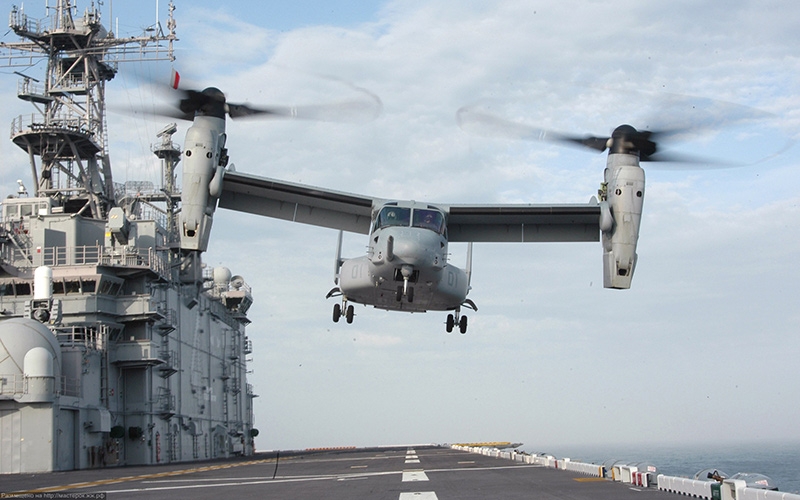
Mass production
Completion summer 2005 year operational test V-22 "Osprey" encourage the adoption of 29.09.2005 program series production konvertoplanov. According to the adopted program, at 2006 fiscal year charted create 11 machines, 2007 – 16, 2008 -24, a 2012 production was to reach the speed of 48 vehicles per year. There were planned purchase 458 konvertoplanov "Ospri»: 50 CV-22 and 360 MV-22, Besides building was planned 48 MV-22 for the US Navy. At the company's Bell in Amarillo (Texas) 08.12.2005 ceremony was held transmission housing Marine first MV-22 In Block (166491). This tiltrotor became the 19th, built in 2005 year, and the first MV-22B, which was intended for the armed forces.
"Boeing" company is engaged in manufacturing of the fuselage, chassis, hydro- and Electrical Systems, and is responsible for the integration of electronic equipment. The company "Bell helicopters Tek-strontium" is responsible for the production of wing, nacelles, empennage, dynamical systems, nadkrylevogo fairing, ramp.
first 4 tiltrotor MV-22 LRIP (small-lot production of primary, Low-Rate Initial Production) collected in August 2000 of the year. after a disaster,, which took place in December 2000 of the year, in design have made many changes, including changing the cabling wiring and hydraulic highways in nacelles, completion of an operations management system.
following 11 devices of this series (9 MV-22 and 2 CV-22) We booked in May 2003 of the year, yet 11 (8 MV-22 and 3 CV-22) – in February 2004 year and 11 (9 MV-22 and 2 CV-22) – in January 2005 of the year. In September 2005 the year it was decided to launch a full-scale serial production. Hundredth V-22 tiltrotor handed to the customer in March 2008 of the year. In March 2008 year signed a contract to build 26 aircraft vertical take-off / landing and CV-22 141 MV-22 for 5 years.

In accident V-22 8 April 2000 g. killing 19 human
Accidents and Disasters
11.06.1991
Due Wiring mistakes 2 of 3 gyros roll control system channel when the first flight fifth prototype was lost. Aircraft at an altitude of a vertical takeoff / landing 4,6 m touched left nacelle land; a fire broke out and burned tiltrotor. Two people suffered.
20.07. 1992
During level flight the right engine nacelle due to leaking hydraulic transmission accumulated hydraulic fluid. During the transition from the horizontal flight of a tiltrotor mode vertical lowering hydraulic fluid hit the engine, which was the cause of the fire. The fourth prototype VTOL aircraft fell into the Potomac River. The collapse of the US Congress members observed, which organized this demonstration flight. 11 people on board were killed, flights V-22 "Osprey" banned in 11 months. VTOL V-22 in theory can perform vertical takeoff / landing when the single motor, but in this case the fire damaged the clock propellers shafts. Critics of the program say, that for all 17 years of flight tests takeoff / landing with one engine was never implemented.
08.04.2000
Two "Osprey" with the Marine Corps landing simulated quest for evacuation in the dark. V-22 was performed in a single build landing in Marone, Arizona Regional Airport. Pilot driven machine reduced forward speed, afraid to face the leading helicopter, to 72 kmh, wherein the tiltrotor leading decreased with large vertical velocity (about 610 meters per minute). On high 75 m lift right screw sharply decreased, while the left created a screw lift is not changed. As a result, a tiltrotor turned over, fell on the ground. killing 19 people on board. The official version of the disaster has been called hit in the "vortex ring" mode due to excess rate of descent. there is a version, the catalyst of the accident could be a slipstream, created by leading konvertoplanov, but this version is not deeply studied, as in this case, the question posed ability to land a group konvertoplanov. Vertical descent rate "Osprey" after the accident limited 240 meters per minute at a speed of translational motion to 70 kmh (this limit is typical for helicopters).
11.12.2000
Airbase New River (North Carolina) during landing after a night flight training at the time of transition from vertical flight mode to reduce konvertoplanov №18 due to friction and vibration disrupted the integrity of the hydraulic line. Down out two of the three hydraulic systems. Several light bulbs lit up the alarm in the cockpit. Pilot off / on an alarm system, in order to ensure its correct operation. The flight control system due to an error in the software start rocking the machine in the cross channel. Crew were taken 8 trying to regain control, but they did not succeed. Unmanaged device fell in a forest near Jacksonville, (North Carolina) from high 490 m. four people, on board, killing. According to the results of crash finalized software, in nacelles changed gasket hydraulic highways.
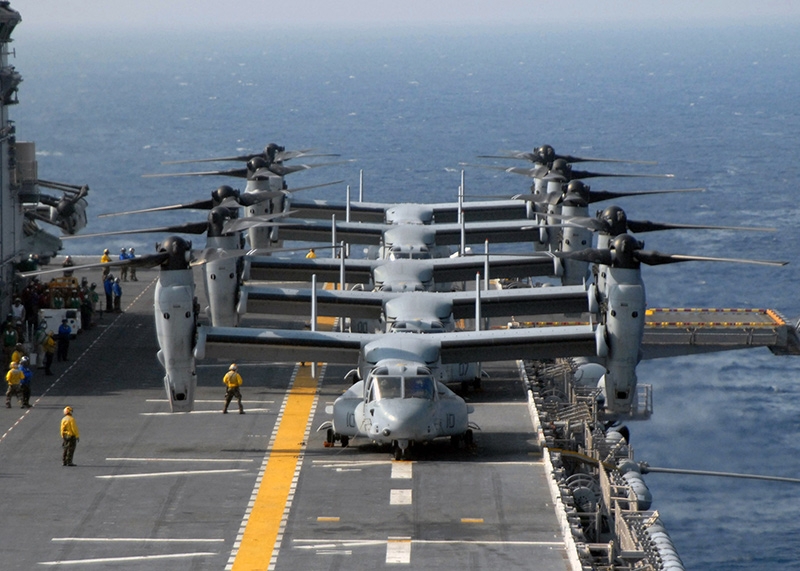
11.04.2012
In southern Morocco during a joint military exercise in the crash “Ospri” killed two marines, who were on board. Another two were injured.
13 June 2012 of the year
MV-22B «Osprey» (1-e Wing USAF Special Operations) - Florida tiltrotor crashed 16:45 when performing a training flight. Five crew members were injured.
21 June 2013 of the year
MV-22B «Osprey» (sir. number 166735, 365-Squadron medium konvertoplanov USMC) - completely destroyed by fire, in an undisclosed location on the Atlantic coast of the US, as a result of grass burning on the landing site. The fire spread from the grass to the fuselage. No injuries were reported.
26 August 2013 of the year
MV-22B «Osprey» (sir. number 168241, 163-Squadron medium konvertoplanov USMC), Nevada - destroyed by fire, after a hard landing near Creech airbase in Indian Springs during the training flight. The crew of 4 people got hurt and had to leave the aircraft before it caught fire.
17 May 2015 of the year
MV-22B «Osprey» made a tough landing during an exercise in the US state of Hawaii. The incident occurred in the area of the air base on the island of Oahu in 11:00 by local time (23:00 MSK). On board the MV-22 Osprey, belonging to the 15th Marine Expeditionary Unit, was 21 human, including 15 Marines and four crew members. As a result of the accident two people died, the others were taken to hospital.
29 January 2017 of the year
During the evacuation of Special Forces Group US Marine Corps in Yemen is one of the konvertoplanov received heavy damage and was later destroyed.
5 August 2017 of the year – MV-22B “Ospri” US Navy crashed off the coast of Australia. On board the crashed tiltrotor was 26 human, 23 were saved.
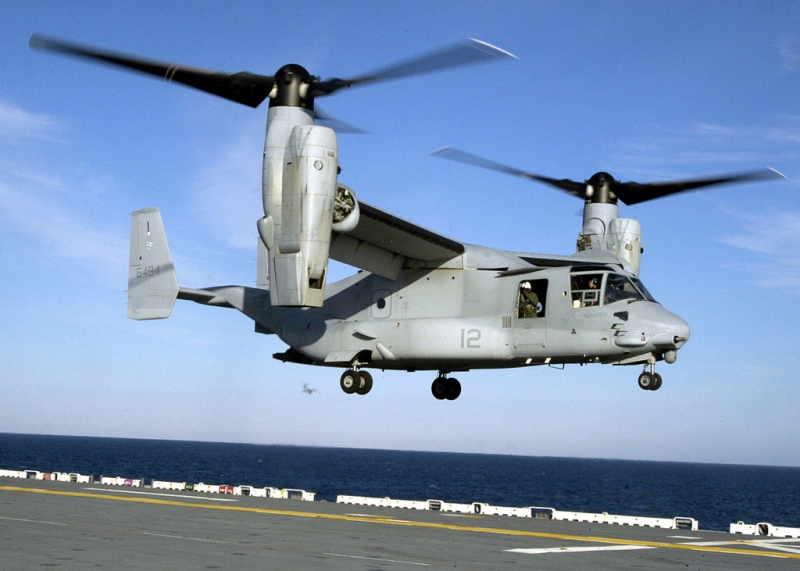
incidents
04.08.2003
Due to the failure of the hydraulic system VTOL performed in the Washington area forced landing.
End of August 2003
On the V-22 "Osprey» №34 during the flight at an altitude of about 2 thousand. m pulled inspection door, Made in the right vertical tail big hole.
23.08.2003
At the airbase Pataksen River takeoff "Osprey» №28 formed a powerful whirlwind, which raised the trash, smashed the windshield glazing VTOL №21 parked near.
02.12.2003
In the V-22 VTOL aircraft during a flight over the state of North Carolina near the left propeller came off of the blade, they cut the left wing plane. Crew emergency landing was made.
12.12.2003
In flight on the "Osprey» №10 of a failure in the flight control system appeared fluctuations. Upon investigation, the accident at the maximum angle of heel during the flight in the helicopter were imposed limit of 10 °.
09.03.2004
Due to the failure of the oil system of the V-22 "Osprey» №43 has carried out an emergency landing.
June 2004
VTOL carried premature landing on the landing craft "Iwo Jima" after, the crew heard an unusual noise during flight. Noise The reason was the destruction of the oil cooler fan.
April 2004-January 2005
During this period was carried out 6 emergency landings associated with an alarm is triggered. In all cases, the cause of the alarm was getting into the oil system delaminated particles chrome coating screw gear bearing.
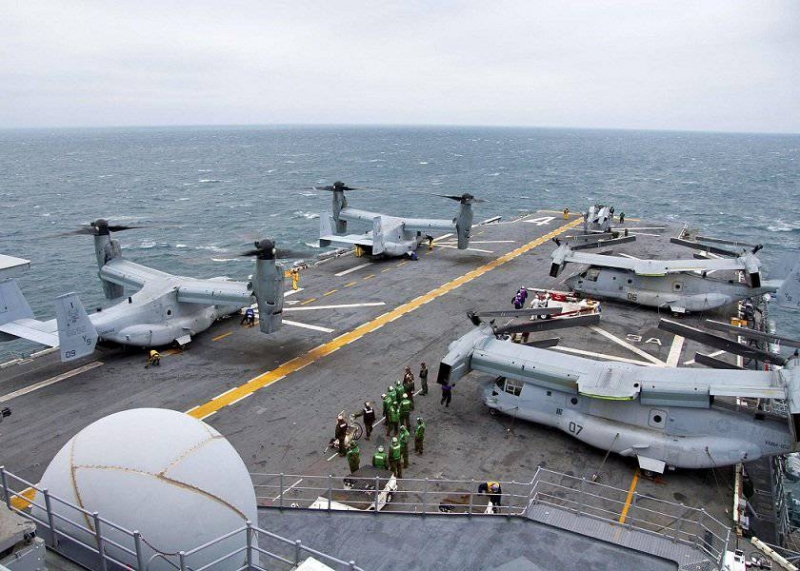
28.03.2005
On V-22 №53 due to leak hydraulic fired engine.
18.10.2005
In the CV-12 on a flight out of order-icing system, for 10-15 minutes was flight in icing conditions. ice chunks, break away from the surface of the glider, tail were damaged, engine and other structural elements. "Osprey" made an emergency landing in Prescott.
begining 2006
At the air base at New River land gazovke was spontaneous increase in engine power. tiltrotor scored 1,8 m, and then I fell to the ground. One wing of the console has received damage. Repair cost in 1 million dollars. The cause of the incident was a mistake in the installation of electrical wiring motor control system.
11.07.2006
When transatlantic flight from the United States to the UK (tiltrotor were to take part in the Farnborough Air Show) one of the two "Osprey" stop right engine compressor. V-22 safely got in Iceland. A week later, there was information about the problems in the compressor motor of the second V-22.
10.02.2007
Flights konvertoplanov V-22 Air Force and Marine Corps temporarily suspended in connection with the discovery of a software glitch in the processor work. This failure could result in loss of control during flight.
29.03.2007
Leakage of hydraulic fluid caused the engine fire before takeoff. there is evidence, in December 2006 year at the airbase New River took a more serious MV-22 fire.
04.10.2007
During a deployment to Iraq is one of the 10 konvertoplanov MV-22B performed in Jordan an emergency landing due to a fault, about the nature of which has not been reported. Apparatus renovated continued execution of the flight, but the crew interrupted the job and returned to Jordan to re-repair.
06.11.2007
Tiltrotor MV-22 ,belongs to a squadron VMMT-204, due to a fire occurred during a training flight made an emergency landing at Camp Lune. Ignition occurred in one engine nacelle. "Osprey" was seriously damaged, but no one on board was hurt. The cause of the incident was a leak in the hydraulic motor filter. The screen-exhaust device hit the working fluid cause a fire. According to the results of a flight accident rework performed on all V-22 Block A, leak hydraulic filters apparatuses Block In expelled at the design stage.
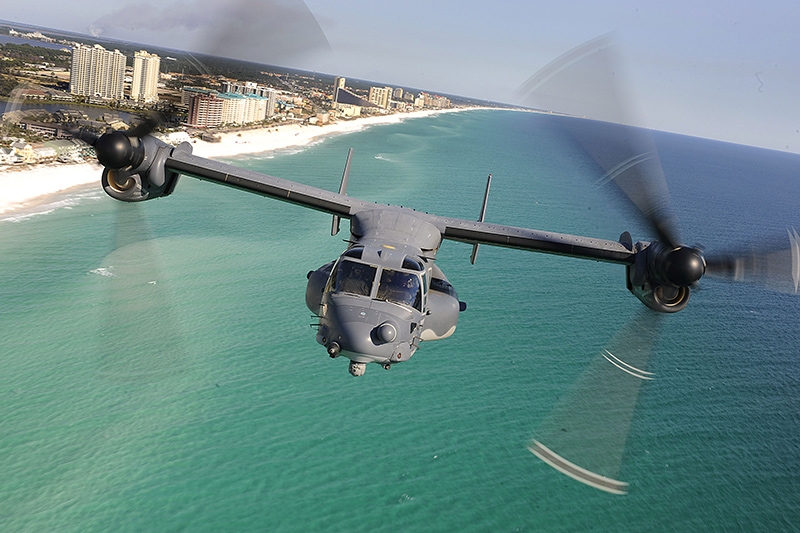
Exploitation and combat use
Marine Corps
Tests tiltrotor in Marine Corps began in the first half of the 1980s on the basis of the VMM-263 squadron. 03.03.2006 agreed, that VMM-263 squadron will be the first in the Marine Corps Aviation rearmed konvertoplanov. The first V-22 "Osprey" (serial №73) Squadron transferred in April 2006 of the year. To end 2008 konvertoplanov year was rearmed 3 tactical (VMM-162, VMM-263, VMM-266, Air Base, New River, North Carolina), training (VMMT-204) and a test (VMX-22) squadron. Crew training 71 Squadron Specialty US Air Force (Kirtland Air Base, New Mexico) supposed to be carried out in the squadron VMMT-204.
VTOL MV-22, the first Marine Corps squadron were armed with VMM-263 «Thunder Chickens» in 2006 year. In June 2007 , she reached the initial state of readiness. Prior to that, armed with a squadron composed of CH-46, about a third flight crew had the experience of combat use of helicopters in Iraq. The composition of the squadron included two women.
Two MV-22 squadron of the unit included in the VMX-22 (konvertoplanov ruled crews "Boeing" and "Bell" companies) in July 2006 year completed a non-stop flight across the Atlantic, to take part in the Farnborough Air Show. VTOL aircraft in preparation for a transatlantic flight Perform flight with Air Base New River (place VMX-22 test squadron deployment), on aviation Miramar base in California. To overcome the route length 3990 km has been spent 9 hours. The return journey took 8 hours. The flight took place at the height of 4,3-4,9 km at a speed of 440 to 550 kmh. Tiltrotor immediately before the flight to London were sent to Goose Bay, Newfoundland. During the flight through the Atlantic V-22 "Osprey" followed by two tanker aircraft KC-130J.
10 MV-22B from the squadron VMM-263 Marine Corps in October 2007 the year was transferred to Iraq. Squadron in the Gulf region from Norfolk delivered landing craft "Wasp", the last section of track tiltrotor overcome "own power". Before deployment to Iraq were carried out intensive exercises in a desert air base in the area of Yuma, Arizona.
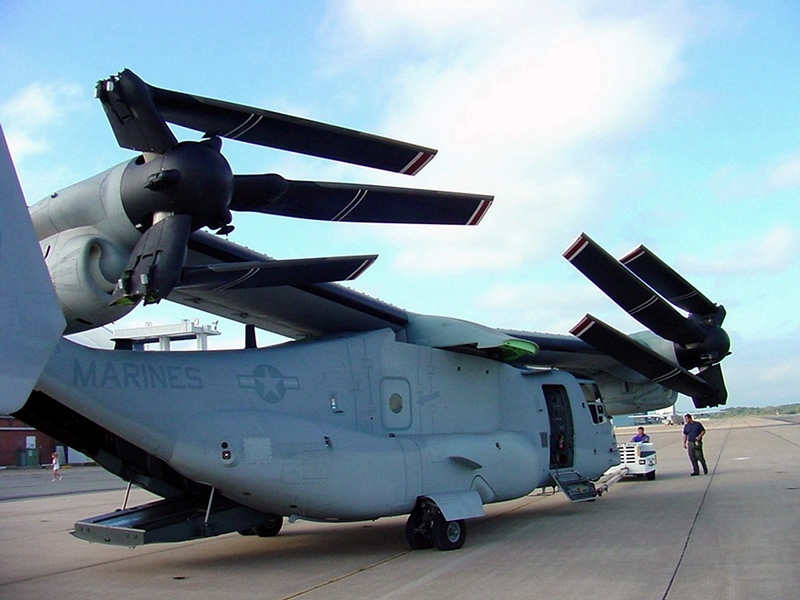
MV-22 Osprey in the folded state
In Iraq, the squadron was located at the air base of Al-Asad. Initially, Al-Asad was sent 10 MV-22, later they added another 2 cars. VMM-263 squadron entered into the Third Marine Air Wing. In al-Assad was the headquarters Wing. In October-December 2007 the crew of the VMM-263 squadron under, equivalent to martial, flown 1650 hours, transported 315 tons and 6800 human. Total Time Spent per squadron in Iraq was carried out 2,5 thousand. assignments, carried over 700 tons of cargo. Suitability konvertoplanov to fly is in the range from 50 to 100%, but, According to Lieutenant Colonel Rock, squadron commander, only one or two times to perform the task failed due to lack of VTOL aircraft airworthiness. Usually 7 of 12 MV-22 is suitable for flight. Average time on maintenance 1 flight hour was 9,5 hours. Average monthly raid on a tiltrotor was 62 o'clock (this figure up to deployment to Iraq was 50 hours).
During 6 weeks in a constant 30-minute readiness to fly round the clock support three crew and two tiltrotor. Tiltrotor at night 24 on 25 December 2007 year rose into the air after receiving an order through 15 minutes. job purpose to delivery was a Marine in Hospital (the soldier suffered an acute attack of appendicitis). crew (copilot - Sarah Fabrisoff, female) the task was performed safely. Marine was taken to al-Assad from point, which was south of the base 125 km. Flight took place at about 2,7 km using an infrared system review the forward hemisphere and the indicator with a moving map of the area. flight, from take-off until the landing, It has been spent 56 minutes.
In addition to performing transport tasks crews worked out combat training missions on the transport of Iraqi army infantry, while in flight accompanied by a tiltrotor helicopter Bell UH-1N and Bell AH-1W outside the squadron US Marine Corps HMLA-773. Under enemy fire tiltrotor of VMM-263 fell only twice. Once the car fired small-caliber firearms, the second time - from the RPG-7.
After VMM-263 squadron was sent to Iraq on 12 konvertoplanov MV-22B of the VMM-162 and VMM-266. Squadron based on a rotational basis in Al Asad. Konvertopolany used to transport goods and people, as well as to carry out "armed reconnaissance", when an opponent was detected from the air, and its destruction was carried out by the landing was in konvertoplanov.
In May 2007 year, the VMM-263 squadron returned to the United States to the place of permanent deployment at an air base New River.
In April 2009 years after 18 months in Iraq tiltrotor MV-22B were withdrawn. Squadron «Fighting Griffin» VMM-266 left Iraq last. For a half-year stay in the VMM-266 swoops Iraq 3040 hours, carried 15800 passengers and 189 tons of cargo.
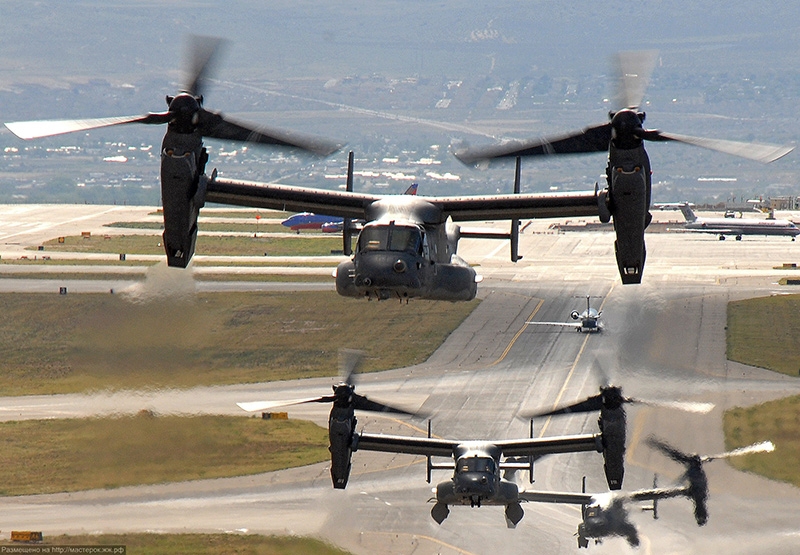
According to Colonel Matthew Malherna program manager V-22 Command aviasistem US naval forces, The success of konvertoplanov in Iraq has surpassed all expectations. Tiltrotor under fire from the ground fell sporadically, no machine has not received battle damage, but 24 Martha 2009 the flights of all park konvertoplanov were discontinued, after technicians VMM-266 squadron on one of the cars was found weakening of bolting in the swash plate right nacelle. Inspection performed after, both pilots were marked by "sharp" noise and an increased level of vibrations during normal flight. Inspection 84 «Ospri», All machines are in operation, It allows to detect such defects by another 4 konvertoplanov, who were in Iraq, as well as one, passing regulations at the air base Marine Corps Cherry Point. FLIGHTS resumed after completion of the inspection, but the daily inspection has been increased by an hour.
Using konvertoplanov in Iraq has caused increased wear some design elements. anticipated, that first of all will be subject to wear and tear of the blade screws, but the Iraqi desert sand so fine, that virtually no negative impact on the blades, but it stuffed in block-by-wire control system and other electronic equipment, causing a short circuit or causing false alarms about the accident. According Malherna, data failures come as a surprise. Engines Rolls-Royce «Liberty» AE1107C, installed on the MV-22B, supplied hydraulic filter Engine Air Particle Separator (EAPS), suction inlets of foreign particles. Tiltrotor sent to Iraq passed revision, during which the filters are supplied with sensors, disconnecting the filters in the event of leakage of the working fluid, because such leak had already become the cause of several fires at an air base in the New River. But the software in some cases, turn off the filters during take-off due to false positive alarm sensors from the powerful vertical airflow. As a consequence - the engines AE1107S "Liberty" is unreliable due to the ingress of sand. To avoid leakage of hydraulic proposes to move the hydraulic line in place, which are less susceptible to heat from the running engines.
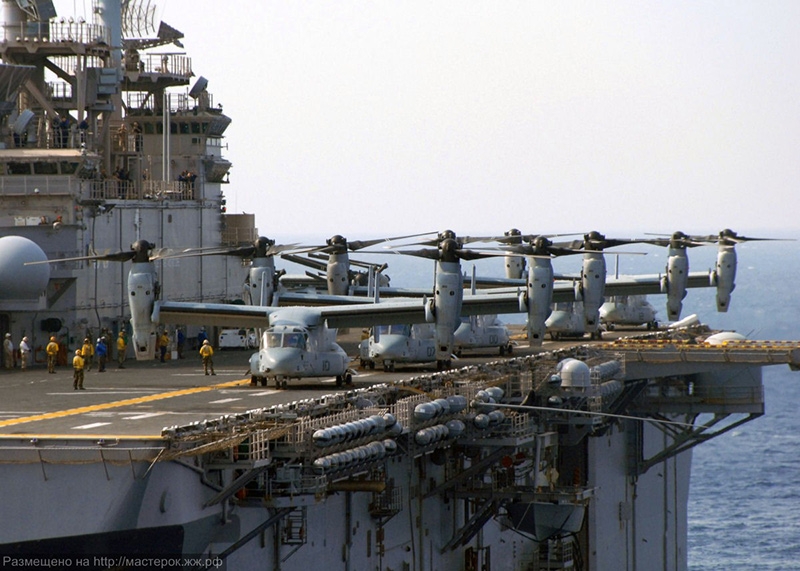
Shortage of capacity and low reliability in the heat engine does not come as a surprise. Less than 7 months of operation in Iraq VTOL MV-22 replaced at least 6 engines. Colonel Malhern during a meeting with representatives of the industry does not rule out the possibility in the future to replace existing engines engines, intended for helicopters CH-53K. Rolls-Royce company many times criticized because of the low reliability of engine installed on the V-22. However, some experts believe, that low reliability is not associated with engine design, and with features for operating the powerplant konvertoplanov. T406-AD-400 engine was developed on the basis of turboprop engines, installed on the C-27J aircraft and C-130J, and well-proven in operation. Experts cause low reliability call entering the engines of foreign particles on the takeoff / landing modes, which differ from konvertoplanov high dusting. Dusting helicopter during takeoff or landing of the norm, However, this effect is enhanced tiltrotor. Helicopter main rotor drops back airflow, while the tiltrotor screws provide two streams, one of which is thrown back, and the second is thrown to the side of the fuselage. Flow, directed towards the fuselage, It increases the "dust accumulation" engine and spin the load placed on the external sling. In this regard, tiltrotor MV-22 transport cargo on the external load only in exceptional cases.
Concern is relatively weak defensive armament - one machine gun caliber 7,62 mm, mounted on the ramp. these concerns, It turned out, It was in vain. Crews MV-22B from the fire from the earth went through a sharp increase in speed and climb. The commander of the crew of one of the noted konvertoplanov: "The speed of 0 to 320 km / h I can just increase 10 seconds ". Survival also contributes less acoustic visibility V-22 "Osprey": if the helicopter off the ground is heard at a distance 16 km, the tiltrotor - 3 km.
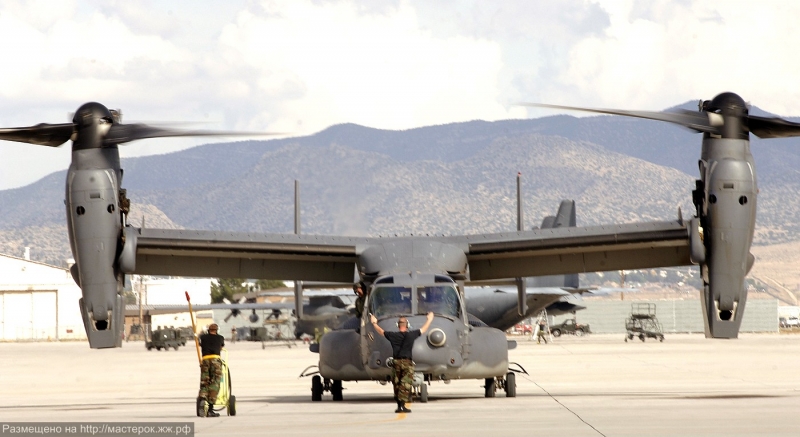
Experience in operating the V-22 "Osprey" in Iraq as a whole was considered successful. But, Despite this criticism note the following facts:
– VTOL used in areas, where there was minimal enemy activity, in particular tiltrotor in Baghdad did not fly;
– most of the takeoffs and landings performed on runways having a solid coating;
– the vast majority of jobs - transport flights between the aeronautical databases;
– Iraqi expedition can not be equated with "test in combat conditions";
– relatively low reliability, which is inherent in all new devices, to V-22 "Osprey" is pretense, tiltrotor because this is not a "new" device: the first flight took place in 1989 year, and mass production has been established in 1999 year - V-22 "older" military transport aircraft C-17;
– low reliability of aggregates, boards and components made of composite materials, predicted in advance, because before you deploy MV-22 in Iraq were sent there parts in the amount of 100 millions of dollars, and to help the VMM-263 squadron in the maintenance of the material part of the corporate traveler 10 experienced company "Boeing";
– to avoid falling into a vortex ring regimes have developed a new method of planting: VTOL was landing on an aircraft and shifted to hover in close proximity to ground, before the touch; This technique is suitable only in the plains (such as the Iraqi desert), but it is unlikely, that this technique will be able to implement in urban or mountainous terrain, which severely limited review;
– data konvertoplanov no offensive weapons, Although the Boeing Company as early as 1999 It was declared on successful testing of the ventral machine gun turret. However, by installing it on the machine serial abandoned due to the construction of the entire apparatus of overweight - the rejection of this armament would save about 450 kg. Placing guns in the cargo cabin is impossible because of the small area of the cockpit windows and screws at the wing tips;
– machine gun, mounted on the ramp, It has a small sector of fire and lack caliber, maintain it during the flight uncomfortable;
– because of the weakness of airborne weapons may not fire cover one another tiltrotor, eg, during evacuation under enemy fire, the type of tactics, used helicopters CH-53, having armed airborne 12.7mm guns;
– due to the probability of occurrence of a vortex ring mode is excluded the simultaneous planting of two V-22 "Osprey", if the distance between konvertoplanov not exceed 75 m;
– VTOL even vulnerable to bombardment of the weapon caliber rifle, as the backbone of all 3 hydraulic systems are laid next to each other in parallel;
– winch for lifting people missing.
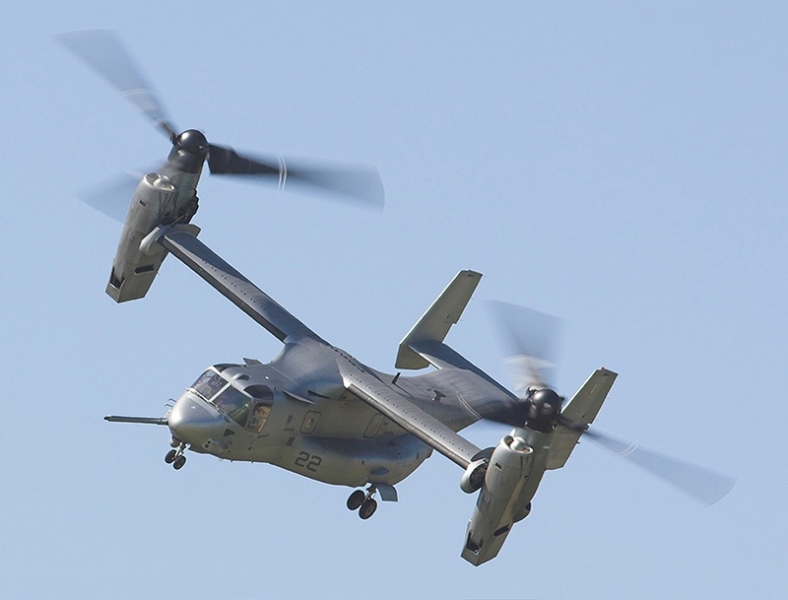
The reliability of anti-icing system raises concerns. It is not designed to work in conditions of significant negative temperatures (which are characteristic of mountainous areas of Afghanistan in winter). defrost system, which consists of more than 200 element, designed for operation of the aircraft under, close to the formation of ice on structural members, but not in a, when it inevitably. Colonel said Malhren, icing system was never properly functioned, and system failures are regular, in particular due to contact with the wiring deicing water system or a mechanical failure caused by high centrifugal loads, created by rotating propellers. Malhern concluded: "The system itself is good, but its individual elements - unsatisfactory ".
According to the results of operation of the V-22 "Osprey" in Iraq, Government Accountability Office (GAO, The Accounts Chamber of the United States Government) in its statement noted, konvertoplanov that required him versatility was demonstrated, but the flight hour cost is twice higher than estimated, and was unable to verify the ability of the machine to perform certain combat missions. In this light, the V-22 participated in the fighting in the province Gelmland for the program as a whole is considered to be critical. celebrated, that in conditions of high heat and tiltrotor show good performance.
Tiltrotor MV-22B «Osprey» 04.12.2009 We took a direct part in the hostilities in Afghanistan. 2 tiltrotor MV-22B included in the VMM-261 squadron operated in a combat Marine Group "Reyderz", providing planting units Third Fourth battalion Marine shelf with helicopters Sikorsky CH-53 in 3 points in the landing Helmand. The landing was made without fire resistance from the enemy. Total parachute 150 Afghan soldiers and 1000 US Marines. Later MV-22B attracted the interest of airborne transportation, to perform the same tasks, as for the medium-lift helicopters.
In November 2009 of the year 10 konvertoplanov from the VMM-261, stationed at Air Station New River (North Caledonia), It was transferred to Afghanistan. Readiness "Osprey" fleet averages 82 percent, but the combat readiness in Afghanistan managed to gradually bring to 80 percent, task to bring it up was staged 90 percent.
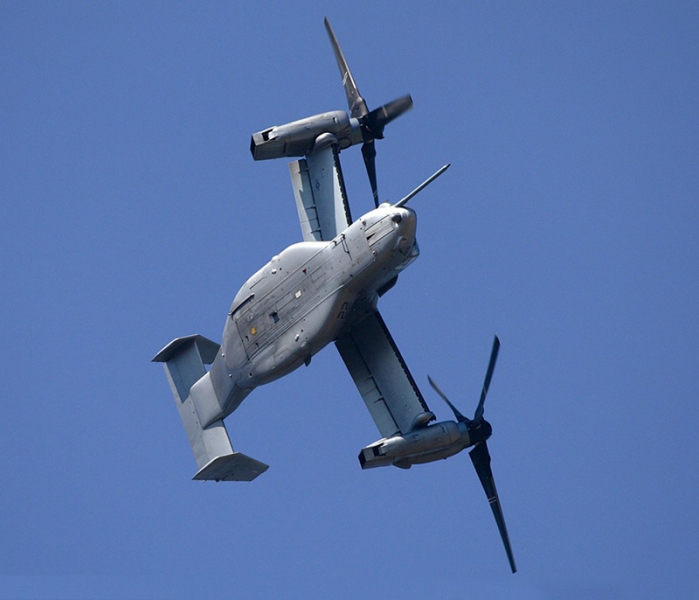
USAF
The Air Force planned to buy 55 CV-22 aircraft VTOL, but later the number of units purchased reduced to 50 pcs. anticipated, that the first 4 CV-22, intended for use in crew training, adopted the 58th training squadron (Kirtland Air Base) go on 2004 year, and in September of the same year 6 machines 8 Squadron (AFB Halbart Field) achieved initial readiness; the supply of the entire party had to be completed in 2009 year. AT 1998 the program was revised to speed up deliveries - all machines on a new plan had to be transferred to the customer in 2007 fiscal year. Receipt of CV-22 by the US Air Force greatly delayed due to disasters 3, as well as delay the flight test program.
In March 2006 the Air Force received the first CV-22 is designed to carry out combat missions. AT 2007 tiltrotor year entered service eighth squadron of special operations forces. 06.03.2009 Special Operations Forces Command US Air Force reported and reaching a state of combat readiness of the original eighth squadron of special operations forces, armed with there 6 СВВП CV-22B. Initial state of alert was declared after 4 CV-22 took the teaching in US joint exercises and 15 allied to the United States of Africa in Bamako, Had. V-22 "Osprey" performed nonstop in Africa and back, using aerial refueling. This has demonstrated the ability to transfer operational independence in any region of the world. Four CV-22 on the African continent during the month were. During the exercises tiltrotor threw Special Forces soldiers from Senegal and Mali.
Overview
MV-22 "Osprey" – Multipurpose VTOL, which is in the design phase is expected to operate in the army, VMS, Air Force and Marine Corps. Later, the United States Army for the V-22 VTOL lost interest. The main customers are tiltrotor Air Force and Marine Corps aviation. options VTOL, which are designed for the Marine Corps and Air Force, almost identical. The basis for all subsequent modifications - MV-22B Block B. CV-22B, modification of the Air Force, by MV-22B is different, mainly, avionics. MV-22B and CV-22B on the airframe is identical to 90 percent, of the power plant - at 100 percent, for electronic equipment - at 40 percent.
VTOL "Osprey" performs takeoff and landing by helicopter, and flying in a horizontal plane as the plane. Transition between the "Helicopter" and "airborne" mode by turning the nacelle equipped with a large diameter three-blade propellers, mounted on the ends of the wing. Vertical take-off / landing when carried nacelle are angled more 85 degrees to the longitudinal axis of the machine. Sustained flight is possible, if located within nacelle 0-85 degrees. Flight "by airplane" is carried out at zero angle install nacelles. "Osprey" is designed to take off and landing with one engine. VTOL not able to perform these operations on an aircraft.
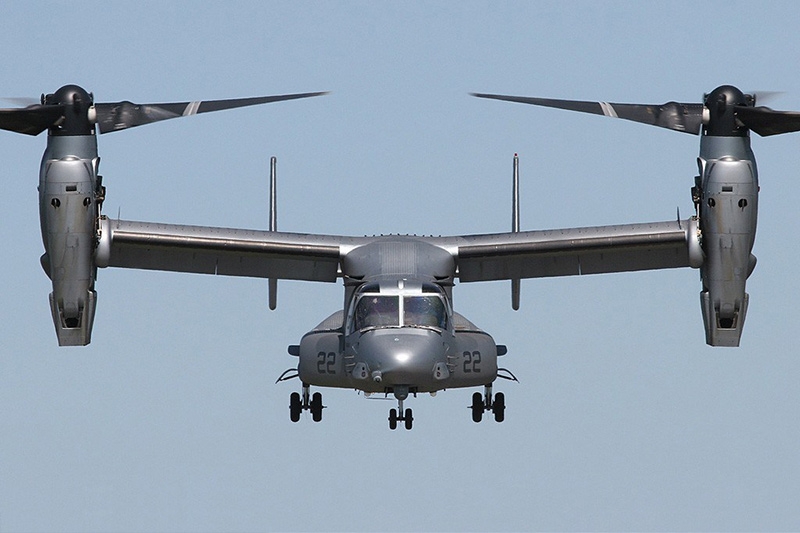
Design
"Osprey" has a high-wing, having a small angle and the reverse sweep dvuhkilevoe plumage. At the ends of the wings rotating nacelle mounted with three-bladed propellers.
Wing-box type with a constant chord (2,54 m) and two side members. The wing is almost completely made of composite materials grafitoepoksidnyh. The upper and lower cladding panels have a monolithic structure. Socks Three-section wing panels are made from aluminum alloy and have a honeycomb filling "Nomex". The wing is mounted on top of the fuselage 2.31 meters circular support, made of stainless steel. Wing supports provide a turn along the fuselage in the case of placing the vertical takeoff and landing on an aircraft carrier deck.
Fuselage semi-monocoque structure has a rectangular cross section. Fuselage length V-22 - 17,47 m. The fuselage is almost completely made of composite materials, fuselage weight V-22 - 1800 kg. On the sides are made fairings, serving to retract the main landing gear; in fairings placed equipment air conditioning systems and fuel tanks. Triple crew cabin located in the bow of the machine. In the cockpit are installed bronekresla, that can withstand hitting 12.7 mm bullets, as well as to overload 14,5 g in the vertical direction and to 30 g in the longitudinal.
In hruzopassazhyrskoy Cabinet carried Can 24 a soldier in full gear. The front fuselage starboard input two-section door formed (lower section outwardly tilts downwards, top - up inside). At a built gangway bottom section. In the rear part of the cabin is lowerable ramp.
Dvuhkilevoe plumage is wholly made of material grafitoepoksidnogo company Hercules AS4. Stabilizer (area 8,22 m2, sweep 5,61 m) mounted above the tail fairing. The total area of 2 vertical fins is 12,45 m2.
Chassis - retractable, tricycle, with the nasal support. landing gear are twin wheels. Nasal support is removed in front of the fuselage compartment turning back. Key support is removed at the side of the fuselage fairings. The chassis has a structure which is designed to fit with a velocity 4,5 meters per second. Main wheels were equipped with disc brakes. The size of the track - 4,62 m.
Construction materials: the proportion of composite materials in the airframe - 59 percent.
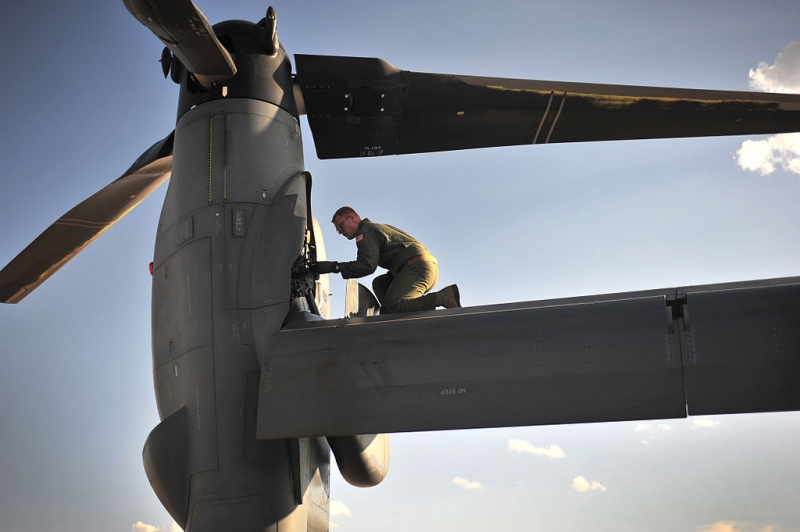
CV-22 Osprey - inspection rotor
Power point
Wingtip mounted in rotary gondolas turboshaft gas turbine engines T406-AD-400 (AE1107S) Company Rolls-Royce. Maximum continuous power of each engine 6150 HP (4400 kW). Turning the nacelle in the range 0-97 degrees. AE1107S has an annular combustion chamber, 14-stage axial compressor, two-stage and two-stage power turbine of the gas generator turbine. The engines are supplied with a digital Lucas Aerospace and analog control system FADEC company (reserve) an electronic control system.
To reduce the visibility V-22 engine nozzle infrared screen-equipped exhaust devices of AiResearch.
The engines are supplied with three-bladed propellers. These blades are made of composite materials based on glass fiber and graphite. Diameter of screw 11,6 m.
Screws are interconnected synchronizing shaft, which is laid inside the wing. Nacelles are rotated by a hydraulic motor with a screw drive.
Fuel system
there is 13 , Compartments of tanks for fuel. In front of both fuselage fairings available on tank-compartment (the total mass of the fuel are placed in these tanks 2860 kilogram), in the rear part of the right fuselage fairing has one tank compartment (925 kg of fuel). The wing box is located 10 tanks, compartments: 2 External used as expendable (305 kilogram), in each of the remaining 8 tanks placed on 227 kg of fuel. Choke centralized charging pressure is placed on the toe right wing, the upper surface of each arm of the wing has a fueling neck. In the forward part of the fuselage on the starboard side mounted refueling boom system during flight. To fulfill ferry flights 3 additional fuel tanks can be installed in the cargo cabin.
Control system
To control the helicopter during flight mode using the cyclic control system and collective pitch propellers. Lateral control in cruise flight is carried out by the two outer deflection elevons. For the longitudinal-section control is used elevator (area 4,79 m), to the track - 2 elevator located on the vertical keels. Control System wire control surfaces, drive - hydraulic.
Mechanization of the wing consists of 4 sections elevons (total area - 4,12 m2), which outer pair are used for roll control.
Is controlled by a cyclic handles (control knob), installed in front of the pilots seats, and engine control levers mounted to the right of the pilots seats. In the engine control levers has a flywheel change nacelle angle.
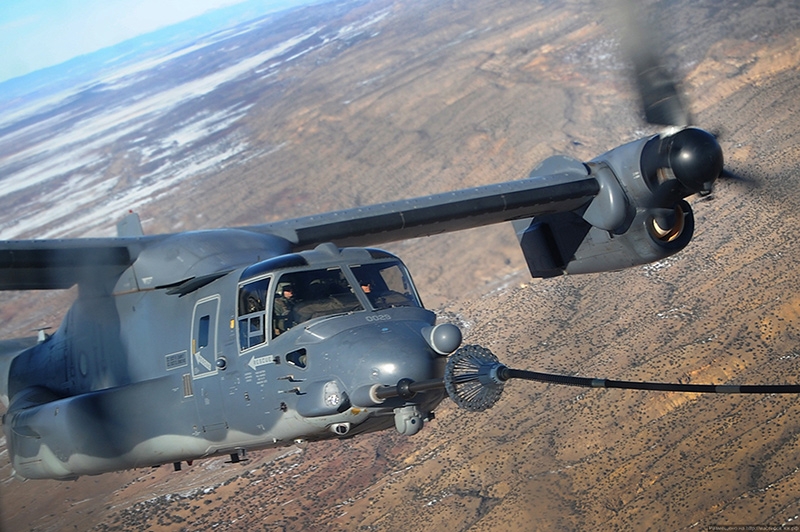
On-board equipment
On VTOL has 2nd main independent and 1 Reserve hydraulic (operating pressure 350 kgf / cm2). The electrical system consists of two alternators (power 40 kVA), two AC generator (power 50/80 kVA), rectifiers, converters, battery. Socks are provided with fins and wing anti-icing inflatable protectors. The front edge of the engine air intakes, coca screws, blades and windshield glazing cabin fitted with electric heating.
avionics
Modifications CV-22B and MV-22B have identical basic airborne electronic systems. In the flight control system has triple redundancy. Radio communication equipment radio communication system consists of ARC-210(V) Channels having a satellite (SATCOM), UHF and VHF svyazi. UHF channel has locked loop. The structure of the navigation equipment includes an instrumental landing system VOR, receivers GPS satellite navigation system and tactical navigation system TACAN, altimeter and inertial navigation system, having a triple redundancy.
The cabin is installed 6 mnogofuknktsionalnyh color indicators, are compatible with night vision goggles. Infrared vision system front hemisphere AAQ-27 Mid-Wave-length Infra Red (MWIR) installed in the lower forward fuselage.
Utility cabin and cockpit have a system of protection against weapons of mass destruction (Atmospheric air is filtered, in the cabins is pressurized).
Onboard Defense Complex consists of APR-39A(V) - warning receiver of the electromagnetic irradiation, AVR-2A – Receiver warning laser irradiation, AAR-47 – about missile launches warning device. Sensors AVR-2A and AAR-receiver 47 installed in 4 sectors VTOL aircraft. ALE-47 chaff system device and ejection of heat traps are placed in side sponsons fuselage; for shooting using manual or 1 of 6 programmed automatic modes.
The forward fuselage CV-22B located multifunction radar APQ-186, which provides flying at different times of day in different weather conditions. station antenna sector scan ± 40 ° in azimuth, from -40 to + 23 ° in elevation. Also on the CV-22B is installed, two additional radio ARC-210(V) and a multi-purpose tactical terminal (Multi-mission Advanced tactical Terminal, MATT). Airborne defense CV-22B reinforced 4th additional blocks shooting traps, which are mounted on the sides of the fuselage behind the nose landing gear compartment support, as well as the back side sponsons. At the CV-22B warning receiver on the APR-39 is replaced by electromagnetic radiation integral set counter in the radio SIRFC, which is capable of automatically pelengovat, classify, as well as to display on the map radio sources (functioning radar). CV-22B VTOL aircraft to counter missiles, equipped with thermal GOS, is staging system aimed AN / AAQ-24 infrared interference.
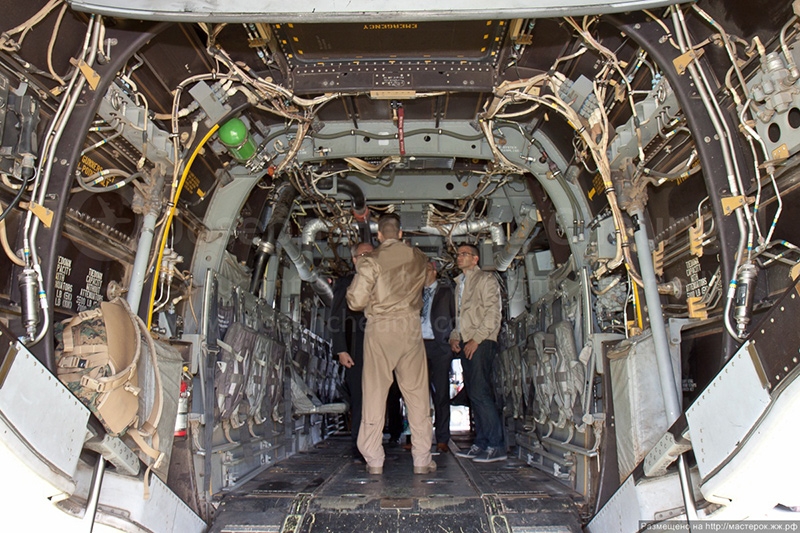
Basing on aircraft carriers
To reduce the space, which takes on board the VTOL, Screw blades are folded along the wing, and the wing unfold in a clockwise direction along the fuselage. For folding rotor blades, and turning the wing requires 90 seconds.
Arming V-22 Osprey
On the lower rail mounted machine gun caliber M240 7,62 mm. The term may be armed tiltrotor 12.7 mm caliber machine gun turret.
The company BAE Systems in January 2008 It has concluded an agreement with the command of special operations forces of the United States Air Force for integration into the design of the V-22 "Osprey" remote-controlled defensive Remote Guardian System (RGS, circular firing system). RGS system with a machine gun GAU-17 caliber Minigun 7,62 mm mounted under the fuselage tiltrotor on external sling instead of the node lashing. Turret after takeoff extends from the fuselage and is removed before planting, for the production / harvesting required 2 minutes. To control the turret using a joystick, Aiming is carried out by means of a camera and screen. RGS system, designed for flight and ground tests, It was first established on the "Osprey" in February 2008 of the year.
modifications
CV-22 – Modification tiltrotor CV-22 is intended to replace the helicopters, MH-53J Pave Low, and part of the air tankers MS-130p Combat Shadow MC-130E Combat Talon special operations forces in the United States Air Force. In their demands to this modification, the US Air Force specifically stated tiltrotor ability to carry out a long flight at night and in conditions of meteorological conditions at low altitudes with high accuracy navigation with maintaining the flight and exit time of a route at a given point. CV-22 can deliver to evacuate from a given area or into it 18 special operations forces soldiers in full gear. celebrated, most konvertoplanov jobs CV-22 will perform at night and / or in adverse weather conditions.
In addition to the basic structure of the onboard equipment has a radar station following the terrain and two blocks shooting thermal traps.
MV-22 - tiltrotor for USMC (3 crew member, 24 or 32 paratrooper)
HV-22 – US naval forces developed their own requirements for modification of V-22 "Osprey", received HV-22 designation. Tiltrotor intended for boats and ships in the sea, as well as for search and rescue operations. VTOL HV-22 to replace the search and rescue helicopter HH-3. US Navy in April 2004 year changed the designation of "their" tiltrotor modifications to MV-22, in the Marine Corps Aviation.
EN-22 - anti tiltrotor for the US Navy
EV-22 - airborne early warning and control for the Royal Navy Fleet UK.
US Navy and Marine Corps presented stringent requirements in respect of these aircraft based on aircraft-carrying ships (amphibious ships, docks, helicopter landing). In particular, These requirements include the unit dimensions (accommodation in the under-deck hangar and plane elevators). Since the diameter of the screws and a wingspan of V-22 is selected from the requirement to ensure when in the takeoff configuration on the flight deck superstructure minimum gap between the island and the disc rotor on the one hand (32,5 cm) and edge of the deck and the screw with the other disc (12,7 cm).
UV-22 – The US Army is exploring the possibility of acquiring 231 UV-22 tiltrotor intended for conducting electronic warfare, transport, search and rescue operations in conditions of enemy countermeasures. UV-22 tiltrotor also had to replace the RC-12 aircraft, RU-21, OV-1 and some other.
Army misspoke ability to lift loads weighing apparatus 4600 pounds (2086 kg) and for 4 hours to fly at altitudes 30 thousand. feet (9144 m) with speed 400 kmh. These requirements imply a larger, than for the Air Force and Navy, aircraft weighing apparatus around 18 thousand. kg, equipped with more powerful engines. The US Army in the spring 1983 year revised the requirements and came out of the program.
Export
There is information about, that the interest in the MV-22 showing Israeli Air Force, which is to be used for a tiltrotor perform search-and-rescue tasks in the interests of special operations forces.
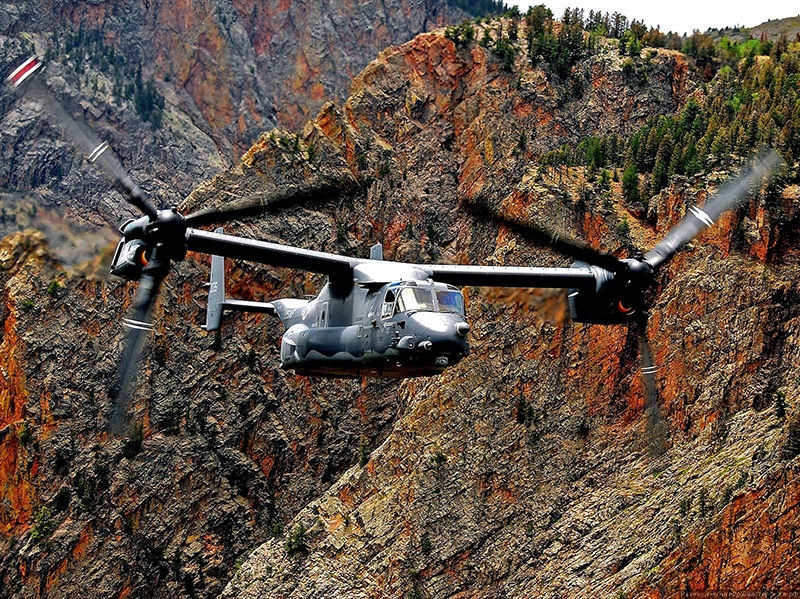
Performance characteristics of the V-22 Osprey
Crew V-22 Osprey
– 3 (MV-22) or 4 (CV-22) man; Passenger capacity - 24 paratrooper.
Dimensions V-22 Osprey
– length of the fuselage - 17,48 m;
– wingspan screws at the ends of the blades - 25,78 m;
– Length when folded blades - 19,23 m;
– width when folded blades - 5,64 m;
– height on keels - 5,38 m;
– with engines, mounted vertically - 6,74 m;
– when folded blades - 5,51 m;
– Wing Area - 28 m².
Weight V-22 Osprey
– empty weight tiltrotor - 15 000 kg;
– the equipped - 21 500 kg;
– maximum takeoff weight - 27 443 kg;
– with vertical take-off - 23 859 kg;
– during takeoff short takeoff - 25 855 kg;
Weight V-22 Osprey
– payload mass - 5445 kg (during vertical takeoff);
– weight of cargo on external sling:
– when using a single hook - 4536 kg;
– with two hooks - 6147 kg.
Volume of fuel tanks
– MV-22 — 6513 l;
– CV-22 — 7710 l;
– Up to three external fuel tanks for 1628 l.
The cargo compartment
– length - 6,34 m;
– width - 1,74 m;
– height - 1,67 m.
Engines V-22 Osprey
– engine's type: 2 × Rolls-Royce T406 (AE 1107C-Liberty)
– power - 2 × 4586 kW (6150 l. from.);
– number of rotor blades - 3 PC.;
– rotor diameter - 11,6 m;
– sweeping surface area - 212 m².
– Nominal rate of climb - 5,5 m / s;
– Maximum rate of climb - 16,25 m / s.
– The load on the rotors - 102,23 kg / m.
– power available - 427 W / kg.
Speed V-22 Osprey
– Maximum speed in the airplane mode - 565 kmh;
– Maximum speed in helicopter mode - 185 kmh.
– Cruising speed - 510 kmh.
Flight range V-22 Osprey
– The range of the combat radius - 690 km;
– The range of the range of the load at the landing - 722 km;
– Practical range - 2 627 km (unrefueled);
– The practical range with the vertical takeoff - 2 225 km;
– Practical range during takeoff short takeoff - 3 340 km;
– Ferry range - 3 892 km (with refueling).
Ceiling V-22 Osprey
– 7 620 m; with one engine - 3 139 m.
Maximum Overload V-22 Osprey
+4/−1 g.
Photo V-22 Osprey
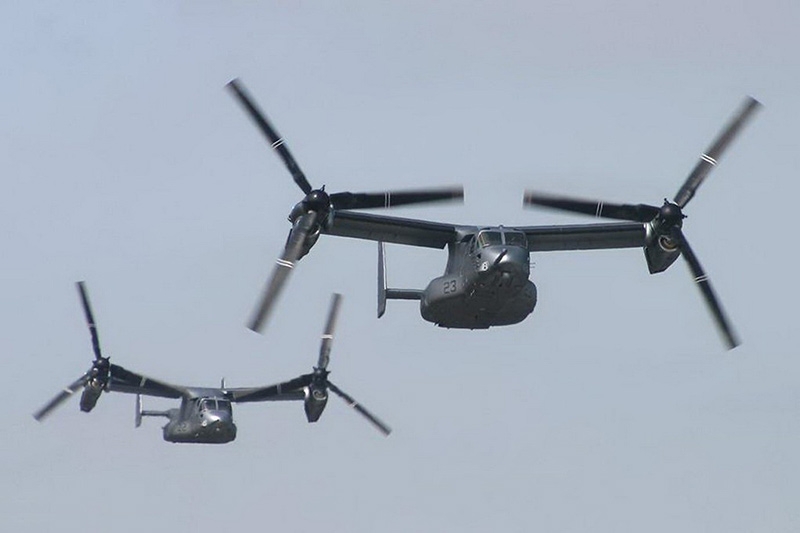
Cab V-22 Osprey
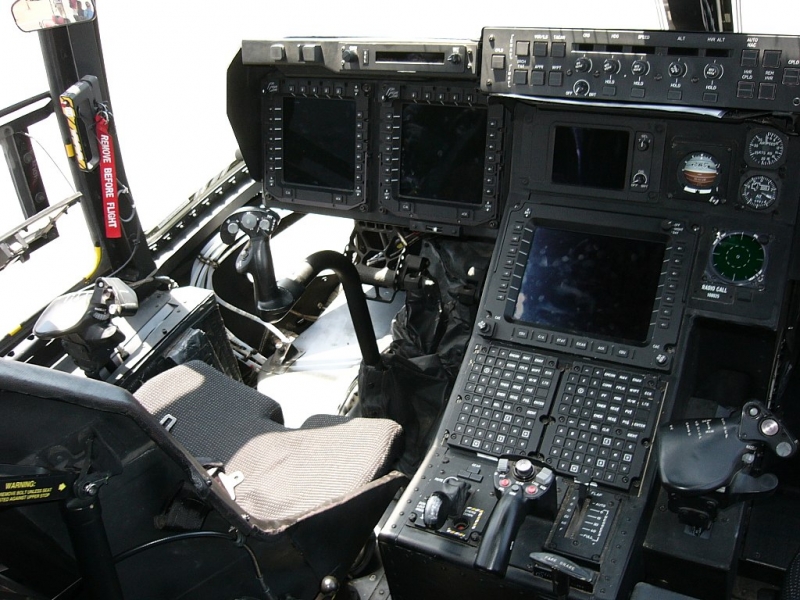
Cabin crew MV-22 Osprey. Draws attention to the unusual shape of bodies (handles) LA management.
